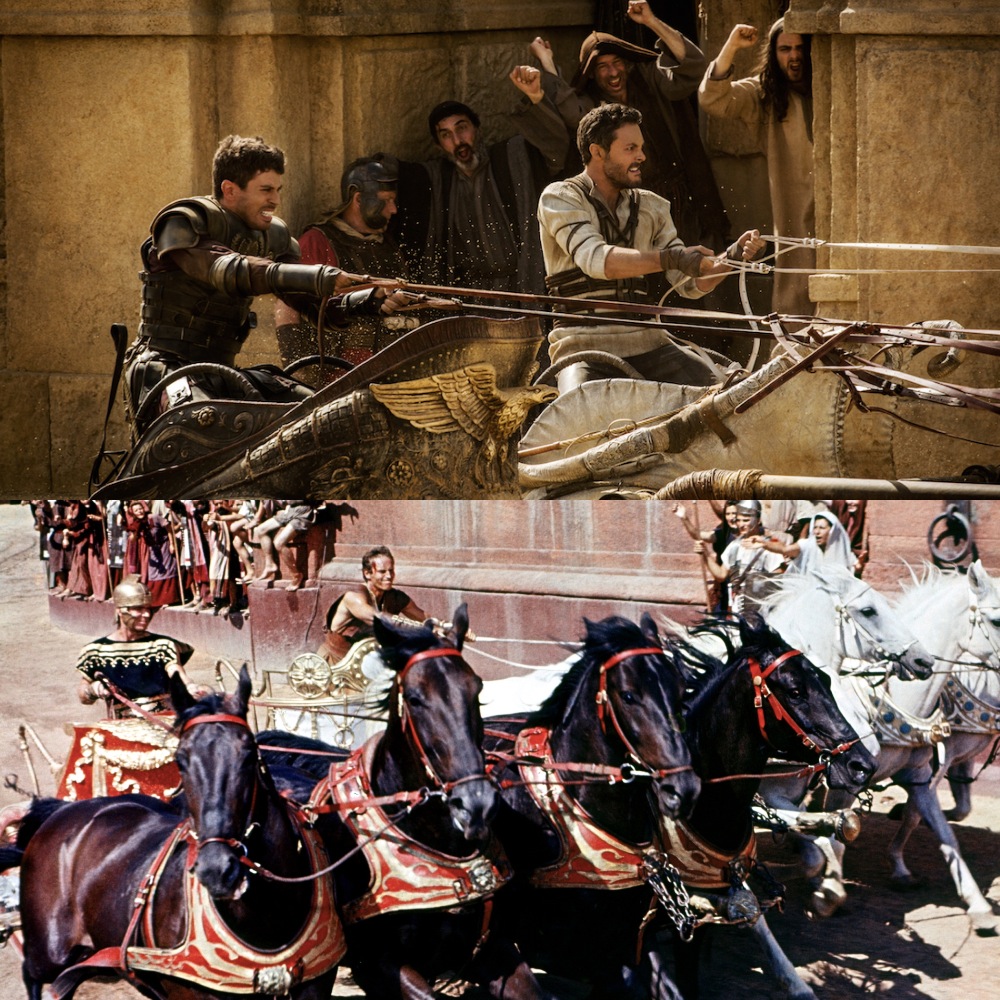With more than a little hesitation I recently attended the latest version of “Ben-Hur,” directed by Timur Bekmambetov. Its 1959 predecessor, directed by William Wyler, was not precisely a bona fide masterpiece but I’ve always had a soft spot for it. As a kid I grew up believing that the religious-themed mega productions from the 1950s represented Hollywood at its most spectacular. Their epic lengths and musical overtures/intermissions only added to this idea (I also used to be convinced that their content was surely 100% faithful to history!). Wyler’s version of “Ben-Hur” was (and still is) head and shoulders above all other entries in this category. It didn’t suffer from “Samson and Delilah’s” (1949) cheesiness (think of the phony lion fight and falling temple) nor was it quite as overblown as Charlton Heston’s own “The Ten Commandments” (1956). Whatever its idiosyncrasies, it truly was a one of a kind experience that showed the old studio system at its peak going all for it.
At its core, the fictional Lew Wallace story of Judah Ben-Hur is basically a revenge movie in the “Gladiator” tradition. But by setting the protagonist’s tragic betrayal in the hands of childhood friend Messala during the events surrounding Christ’s crucifixion, his suffering and redemption gained special weight and meaning. From a cinematic point of view, the 1959 “Ben-Hur” holds up rather well to this day and there is no doubt that its chariot race is still one of the greatest action scenes of all time. Just place it alongside with the rather brief one in “Quo Vadis” (1951) that is shot with background photography, and the difference is mind blowing. Time hasn’t been quite as kind with “Ben-Hur’s” other renowned set piece (the maritime battle), as it is now painfully obvious how it was shot in a tank at the studio lot. The film as a whole is very much a product of its time, with perfectly shaven and bathed characters, whose clothes seem like they just came out from the manufacturing line, as were their shiny new shields and helmets. The acting, as was often the case in those days, is the very definition of hammy and is best remembered by the endless, preachy dialogue between Charlton Heston and Haya Harareet while both stood cheek to cheek, their eyes pointing to the sky.
The 2016 version of “Ben-Hur” has its own share of peculiarities. Most of the central characters look much too cool and contemporary. The best example of this comes in the sequence where the new Judah (Jack Huston) and his wife Esther (Nazanin Boniadi) are shown riding a horse while wearing rather fashionable pants. Not only do I have my doubts that such a garment had already been invented at that point in history but most importantly, a woman wearing such during those days would have surely caused quite the scandal. One thing that made Mel Gibson’s “The Passion of the Christ” (2004) so believable was how beat and dirty its protagonist looked (as was surely the case). But even though this new “Ben-Hur” is set at the same time period, it is more concerned with making sure its leads are attractive enough so today’s audiences will want to identify with them.
Charlton Heston may have won the Academy Award for Best Actor for the 1959 version of “Ben-Hur” but his performances were always a bit on the theatrical side. I always saw him more as a great screen presence than a great actor but his aura is definitely missed in this new entry anyway. When Morgan Freeman makes his appearance halfway through the new version, one can’t help but breathe a sign of relief at the sight of someone of his stature and familiarity, even if he brings along yet another of his obligatory narrations.
Another problem with the new “Ben-Hur” is that it only does a marginally better job of casting the part of Jesus Christ than the dismal “Risen” (2016), even though the role is given much more importance than in the Wyler version. One of the biggest achievements of “The Passion of the Christ” was making you feel like you were watching the real person but this is hardly the case with the Rodrigo Santoro portrayal. As a result, his dialogue comes off rather heavy-handed and preachy. Perhaps it would have been a better idea to show his presence only from behind, as they once did in the 1959 version.
The main difference between both versions of “Ben-Hur” is that while the 1959 film took its time with everything, the latest one always tries to get to the point as quickly as possible. My guess is that this was done with today’s more impatient audiences in mind. The dialogue in the 2016 version is also more concise, especially that between Huston and Boniadi as (thankfully) Judah is restricted to uttering his favorite line (“Where are my mother and my sister?”) no more than a couple of times. Additionally, several characters are used in different subplots as to keep the number of players to a minimum and others from the older version are eliminated and not terribly missed (think of the Roman General who adopts Charlton Heston after the latter saves his life at sea). The recent version’s relative brevity is mostly for the best, but by having the new Judah made a slave in the galleys, and after just a couple of minutes marking the passage of five years by placing him in the middle of the defining battle, there’s just not enough time to linger on the cruelty of his destiny. As a result, by the film’s end his redemption doesn’t have the same poignancy as it did in the Wyler version. Turning a new and unexpected character into the detonator for Judah’s arrest (as opposed to the tragic, aleatory event from the older film) doesn’t help matters either. It leaves former friend turned foe Messala without much choice but to betray our protagonist, lessening the former’s guilt and the overall impact of the outcome.
What’s best about this new “Ben-Hur” are surely the amazing action scenes filmed by the “Bourne” series’ cinematographer Oliver Wood. The naval battle is obviously CGI-laden but the filmmakers make sure to use the newest technology available to explore every possibility to the action the old version could have never even considered. The same goes for the chariot race in which the special effects seamlessly blend the actors and the extras with these incredibly violent events, such as the sight of one collapsing horse after another, or even that a steed climbing all the way into the stands alongside the terrified crowds. Both set pieces are also edited much more tightly than the originals. Think for example of how the 1959 chariots race included a long introductory sequence with musical fanfare for every participant while the latter takes its own visual achievements for granted and skips it altogether. Even though this new chariot race wasn’t done entirely in reality like the last one, it is still pretty jaw-dropping, the only caveat being that it comes at the heels of several other state-of-the-art special effects movies. The 2016 version of “Ben-Hur” doesn’t feel as unique or special as the old one surely did when it first came out.
Much has been said about how the new version of “Ben-Hur” gives special emphasis to Judah’s reconciliation with Messala. Even though Charlton Heston was never given the opportunity to forgive his Stephen Boyd’s counterpart directly in the prior entry, the feeling was clearly implied but despite the filmmaker’s best intentions, by having Huston’s Judah doing it on-screen this time around, the new film’s conclusion feels much too forced. Still, it’s hard to understand why the 2016 version of “Ben-Hur” flopped at the box-office so badly. The Lew Wallace story may lack the twists, turns and the edge that are so common in today’s movies but it works just as well today as it did 50-some years ago. There are plenty of things that could have been better about the new “Ben-Hur” and the following may not be the best possible endorsement, but I was surprised that its distance to greatness was a heck of a lot shorter.












